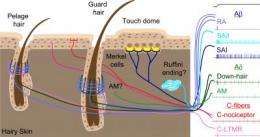New perspectives on sensory mechanisms

The latest Perspectives in General Physiology series examines the mechanisms of visual, aural, olfactory, and tactile processes that inform us about the environment. The series appears in the September 2011 issue of the Journal of General Physiology.
Everything that mammals perceive about the environment is based on the transmission to the brain of signals originating in sensory organs such as the eye, ear, nose, and skin. As described by UCLA researchers Robert Farley and Alapakkam Sampath in their introduction to the series, the encoding of sensory information is initiated by specialized peripheral sensory receptor cells and refined by local neural circuits, with both excitatory and inhibitory inputs ultimately analyzed and interpreted in the cerebral cortex.
The Perspectives series provides a comprehensive summary of what is currently understood about the mechanisms of information processing in multiple mammalian sensory systems. Such a comparative approach across systems provides insight into the common strategies that might be used by researchers to quantify and characterize that information.
In the Perspective series, Schwartz and Rieke discuss the visual system, where the physiological mechanisms of sensory encoding have been most investigated; Bautista and Lumpkin focus on the cells and molecules that mediate light touch in the periphery; Reisert and Zhao focus on how olfactory receptors cells encode the presence of odorants in the environment; and Zhang et al. emphasize the important and varied roles inhibitory mechanisms play in encoding auditory signals.
The purpose of the Perspectives in General Physiology series is to provide an ongoing forum where scientific questions or controversies can be discussed by experts in an open manner.
More information:
Farley, R.A., and A.P. Sampath. 2011. J. Gen. Physiol. doi:10.1085/jgp.201110666
Schwartz, G., and F. Rieke. 2011. J. Gen. Physiol. doi:10.1085/jgp.201110629
Bautista, D.M., and E.A. Lumpkin. 2011. J. Gen. Physiol. doi:10.1085/jgp.201110637
Reisert, J., and H. Zhao. 2011. J. Gen. Physiol. doi:10.1085/jgp.201110645
Zhang, L.I., et al. 2011. J. Gen. Physiol. doi:10.1085/jgp.20111065

















